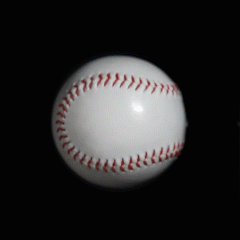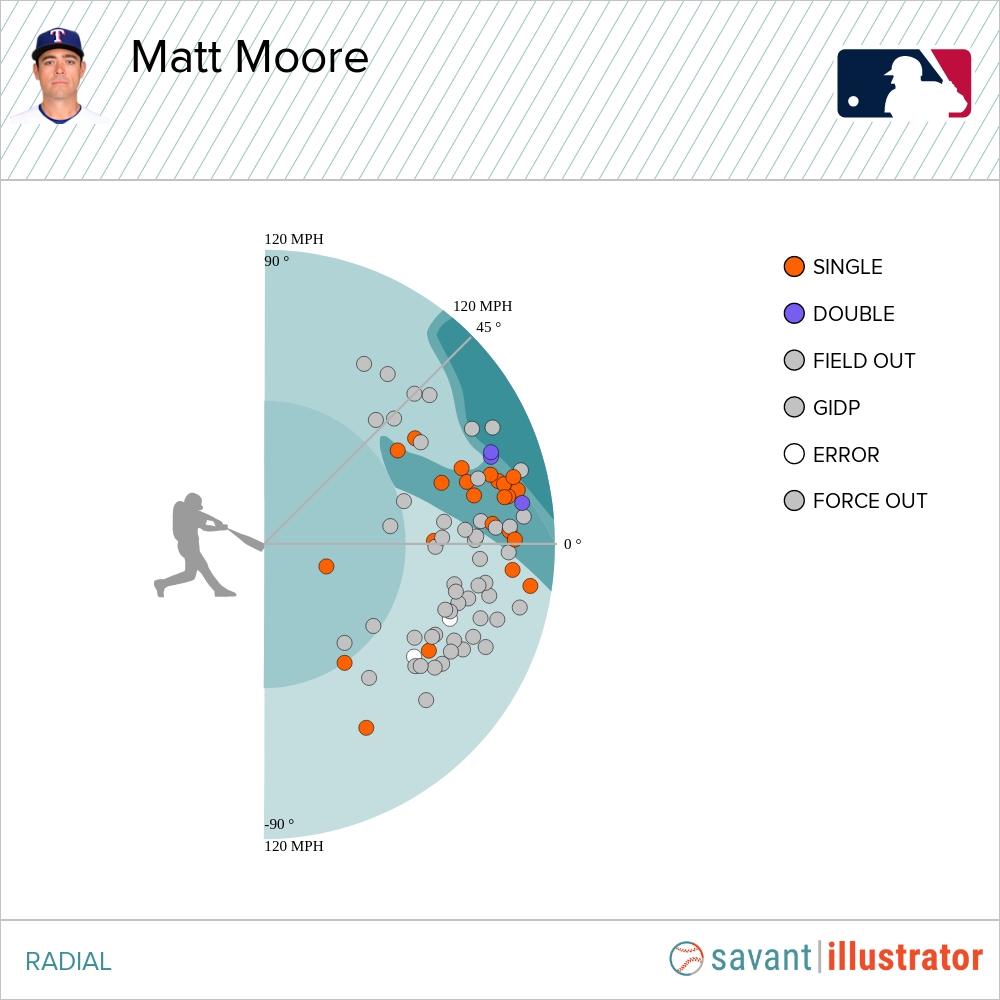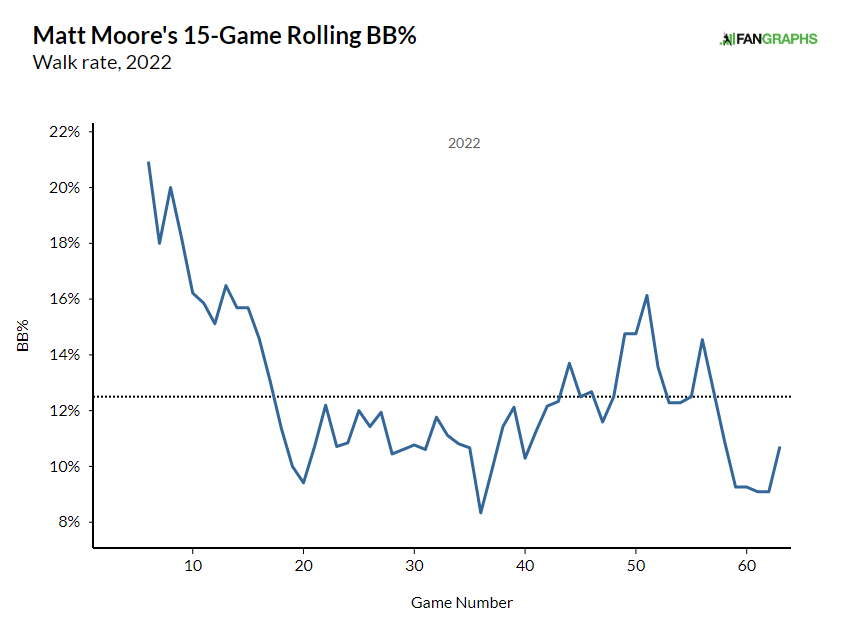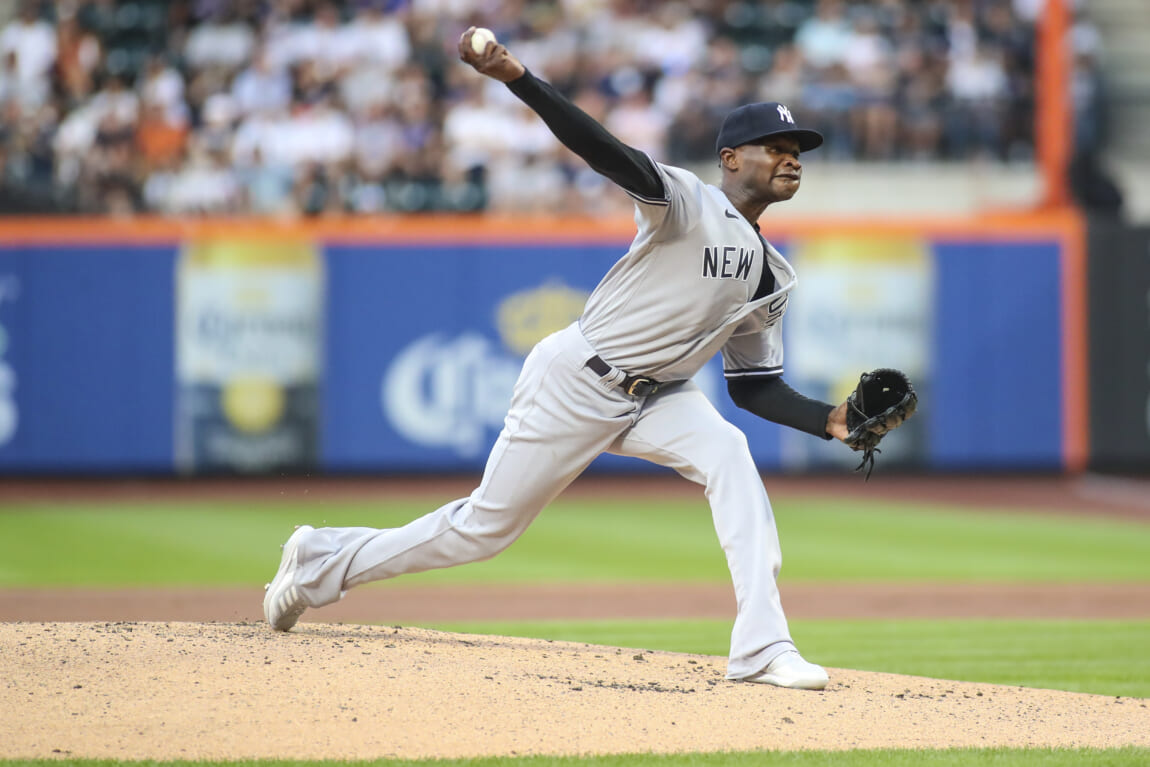
Free agency is drawing to a close, with most of the top options finding new homes or staying where it all began. The Yankees have done most of the heavy lifting already this offseason, and while LF remains the largest question market on the roster, if they aren’t able to address it, they shouldn’t just sit on their hands. This team, for the most part is highly well-rounded with plenty of young and veteran talent, but there’s an old adage that has been around as long as baseball’s been played: You can never have too much pitching.
The Yankees are lacking in terms of having left-handed options out of the bullpen, but perhaps they could go to a starter-turned-reliever in Matt Moore, and with pitchers and catchers reporting soon, he could end up having to settle for less than he expected. If he falls into the Yankees’ price range, they could add the final piece of what would be the best bullpen in baseball.
- Yankees activate exciting outfield prospect off of IL, remains in Triple-A
- Yankees are ‘actively’ targeting help at 3B at the trade deadline
- The Yankees need to make a big push for this perfect infield trade target
Boasting an Impressive Vertical Profile
Added regulation on shifts next year places an emphasis on getting swings and misses, with strikeouts becoming a far more desirable outcome. The BABIP on groundballs could rise next year, but the BABIP on a strikeout will always be 0. Matt Moore struck out 27.3% of batters faced last year, ranking him in the 77th Percentile. What’s just as important as your strikeout rate is the shape of your strikeout rate, as if it’s not sustainable, there could be issues with projecting an above-average K-rate in 2023, something that we need to keep an eye on whenever evaluating potential additions. The metrics we’ll use are Chase%, Whiff%, CSW%, and Stuff+ to figure out if his K-rate is sustainable.
Chase%: A metric that allows us to evaluate how often swings are taken on pitches out of the zone. It’s calculated by taking data only from pitches out of the zone and dividing the total swings by the total pitches.
Whiff%: This metric allows us to see how often a batter comes up empty on a swing, it’s simply the total of swings and misses divided by the total amount of swings.
CSW%: Called Strike + Whiff rate is a metric that strongly correlates with strikeouts and evaluates how often a pitcher either generates a swing-and-miss or called strike.
Stuff+: Developed by Eno Sarris of The Athletic and Max Bay, who now works for the Astros’ Research and Development team, it’s a metric that evaluates a pitch’s shape, velocity, movement, spin rates, release points, spin angles, and movement differences off of a fastball.
With the four metrics we’ll be using here defined, let’s get into the nitty-gritty of how stable Moore’s strikeout rate is and if it’s something we can project positively going forward.
| Metric | MLB Average | Matt Moore |
| Chase% | 28.4 | 31.7% |
| Whiff% | 24.7 | 31.1% |
| CSW% | 27.5% | 29.1% |
| Stuff+ | 100 | 110.4 |
It’s safe to say here that Matt Moore’s sudden emergence in K% isn’t some fluke but was done sustainably in a manner that we can expect him to maintain or improve upon going forward. Moore accomplishes this by throwing a ton of pitches with strong vertical deception, and it all starts with his four-seam fastball. When we look at the characteristics of a good four-seam fastball, we see that Moore checks off a lot of those boxes. Let’s start with pitch movement, with 18.1″ of Induced Vertical Break, Moore’s fastball plays up in the zone, where you tend to see fastballs get plenty of swings and misses.
Batters hit just .179 against the four-seam fastball with a .358 SLG and 26.6% Whiff%. It’s a high-spinning fastball at 2,385 RPMs of spin, but that’s not the only reason it generates strong movement. With a 98% Active Spin Rate, all of its spin is going directly toward movement, meaning you’re getting plenty of backspin which fights against the force of gravity. It creates a “rising” effect, but as we know, due to gravity, a baseball can’t actually rise, though what it can do is drop less than expected.

As you see in this GIF (don’t ask me how to pronounce ‘GIF’), all of the movement on this ball is going toward backspin, and with Moore accomplishing the task of generating high spin efficiency, the 84th Percentile fastball spin rate he has is going to all go towards fighting gravity as it travels to the plate and generate less drop than expected. This is why Moore’s fastball generated so many whiffs and why batters would routinely pop it up or hit a weak flyball. With the shift being regulated, his primary pitch having the shape of one that generates strikeouts and soft contact in the air, shouldn’t be affected much at all.
- Yankees activate exciting outfield prospect off of IL, remains in Triple-A
- Yankees are ‘actively’ targeting help at 3B at the trade deadline
- The Yankees need to make a big push for this perfect infield trade target
He used his fastball 45% of the time in 2022, but let’s evaluate the other pitches he mixes in that have played a pivotal role in his ability to work up and down the strike zone and change eye levels.
His go-to breaking pitch, Moore’s curveball, is a phenomenal pitch for his arsenal as it generates over 50″ of drop and separates excellently from his four-seam fastball. With just a .238 wOBA allowed and 29.5% Whiff%, his curveball was excellent despite below-average spin (41st Percentile). A fastball-curveball combination is classic, and with a 120.4 Stuff+ on the pitch, it’s a great pitch all on its own. He uses his curveball as a strikeout pitch, of course, but it’s also a great groundball inducer at a -3° Launch Angle last season. I previously mentioned how groundballs could have higher BABIPs next year, but that doesn’t mean all groundballs are bad.
Having a groundball pitch for a double-play scenario is important, and Moore’s ability to balance out his GB/FB numbers allows him to completely repel line drives. The name of the game when allowing contact isn’t to manage exit velocity as much as it is to manage launch angle. Line Drives are a hitter’s dream and a pitcher’s nightmare, but by allowing just 16.7% of his batted balls to go for line drives, it’s no surprise that he was able to suppress his BABIP allowed. He held a .257 BABIP last season, significantly lower than the .290 league-wide clip in 2022.

We see that the majority of batted balls against the curveball came on the ground, as 54 of the 81 batted balls against Moore registered a launch angle under 10°. That comes out to a 66.7% GB%, an effective pitch for whenever the situation calls for it. The best part is his changeup is arguably the better non-fastball of the two despite his curveball’s excellence.
Batters couldn’t figure out Matt Moore’s changeup, registering a .167 wOBA against and a 45.7% Whiff%. At a -2 Run-Value/100, it was his best pitch on a per-rate basis last season. It’s important to note that just because a pitch is better on a per-rate basis doesn’t mean a pitcher should necessarily increase its usage, but that’s definitely something to note going forward for Moore. It was his best strikeout pitch, and with nearly 10″ of vertical separation off the fastball and 17″ of run, it’s an absolutely gross pitch.
Changeups have always done well at limiting hard contact, and with an 85.6 average exit velocity allowed on the pitch, he was able to avoid any hard contact on that pitch. He threw the pitch 210 times, and yet only one batter registered an XBH, a double by Rafael Devers on September 1st. Overall, his pitch mix is able to neutralize RHBs and LHBs, though he’s definitely better against RHBs. With his arsenal out of the way, let’s discuss the elephant in the room.
Saying Yes to Walks?
Matt Moore’s biggest issue is command, something that’s consistently been an issue throughout his whole career. This past season we saw his highest BB% (12.5%), and thus, his K-BB% was just 14.8% on the season last year. Anyone who has seen my Twitter page is aware of how much I dislike walks, but sustainable run prevention ultimately matters more than what I like or dislike. We saw that Moore was able to improve his walk rate throughout the season, but he still posted just a 96.8 Location+ and isn’t going to live in the strike zone.

The way I view Matt Moore’s command issues is that it’s not good, but his BABIP suppression and ability to generate strikeouts should allow him to continue to be a good pitcher going forward. Removing April, where he walked 22.2% of batters faced, he walked 11.2% of batters which is definitely more manageable. If he can somehow get it to just 10%, that would be incredible, but we’re asking for more than what we saw in 2022, where he had a 1.95 ERA. He definitely has the ability to go out there and strike out closer to 30% of batters faced with an ~11% BB% and .260-.270 BABIP, we’ll look at sub-3 ERA once again.
Ron Marinaccio is another arm that falls in the category of line drive suppressor with great stuff and poor command, and the Yankees clearly care more about Stuff over Location for their bullpen. Like it or not, it’s worked excellently in their favor for their bullpen. There’s a premium on high-level stuff in short spurts out of the bullpen, and even in spite of poor command, Moore’s arsenal will play up to snuff.
Multi-Inning Versatility
Matt Moore tossed 74 innings last season, ranking in the top 10 for innings pitched, and having 14 outings where he tossed 2 innings. The Yankees have a multi-inning weapon in Michael King, but it definitely doesn’t hurt to have a second. The situations in the 7th and 8th you can use him in, or the extra inning situations where you don’t know how long the game could go, would definitely help the Yankees as well. He’ll slot in the middle of their bullpen, giving them a left-handed option who they don’t have to worry about with platoon splits, and they can let go past one inning.
Another angle to this situation is that Moore could be an opener if need be for a bullpen game or come in if a starter is knocked out early, as he does have experience as a starter. There would be a legitimate question about the roster space with Moore on the team, as when Frankie Montas returns, it would create a situation where they’d have to DFA German to keep Moore. It would hurt your SP depth slightly, but Moore’s able to throw 2-3 innings in a pinch.

The Yankees are a team that also has arms like Randy Vasquez or Jhony Brito, who could definitely fill in for Domingo German if he had to be moved to open up room for Matt Moore. If we’re going based off of ZiPS, Brito has a projected 4.20 ERA over 105 IP, while German has a 4.10 projected ERA over 98.2. While a small sample size, in Spring Training, we saw a 103 Stuff+ from Brito compared to a 102.3 from Domingo German, so they’re awfully similar pitchers.
Evaluating what the bullpen would look like, we’re talking about one of the most talented bullpens in baseball, top to bottom.
- Lou Trivino
- Tommy Kahnle
- Matt Moore
- Ron Marinaccio
- Michael King
- Jonathan Loaisiga
- Wandy Peralta
- Clay Holmes
Adding a pitcher who had a sub-2 ERA and sub-3 FIP all depends on the price tag, and if it reflects the one FanGraphs has for him at $5 million, so the Yankees have to clear over $4 million in payroll to stay below the Steve Cohen Tax at $293 million. Moving Isiah Kiner-Falefa ($6 million) and Domingo German ($2.6 million) would seemingly do the trick and give the Yankees $3-4 million to still play with at the trade deadline or if they want to still add a left fielder. It seems increasingly unlikely that they move Aaron Hicks due to the lack of callers but also due to their outfield depth as well.
While it’ll come at the cost of potentially adding a LF, the Yankees could go out and have the best bullpen and pitching staff in the sport this year with Matt Moore.